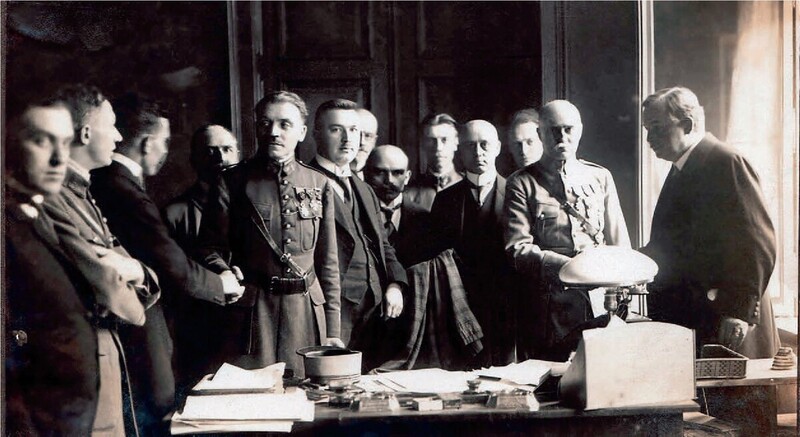The associations evoked in the title were mainly associated with British officials and soldiers, who appeared in Upper Silesia as administrators of the area and as guardians of order until its fate was decided in a plebiscite. The reason for this connotation was the similarity of behaviour of the pro-Polish Upper Silesians and the supporters of the creation of an independent Irish state, who caused the April 1916 Easter Rising in Dublin. The pro-Polish Upper Silesians took up arms three times, and although each of the insurrections had slightly different goals, all of them were directed against the German administration and authorities, becoming evidence of dissatisfaction on the part of the inhabitants with the status quo and their aspiration to incorporate the region into Poland.
The fact that the basic objective of the pro-Polish Upper Silesians was the same did not mean that the means they used were uniform. This was clearly evidenced by the situation at the end of the Third Silesian Uprising, when the “East” group mutinied.
The members of the group (including the later Silesian Voivode Michał Grażyński) believed that the diplomacy promoted by Wojciech Korfanty should be replaced by armed struggle, which would result in the insurgents’ military victory over the German opponent. The arrest of the group’s members and the suppression of the revolt were the genesis of the open dispute between Grażyński and Korfanty which lasted throughout the interwar period. The fact that the coordination of the insurgents’ activities temporarily remained in Korfanty’s hands led to the suspension of military operations on 5 July 1921.
Skirmishes were the order of the day
The results of the Upper Silesian plebiscite (59.4% of the voters voted to remain within Germany’s borders, and 40.3% to into incorporate Poland), as well as the principle, planned earlier in the annex to Article 88 of the Treaty of Versailles, that “the expressed will of the people (counted in municipalities) shall be taken into account”, together with “the geographical and economic situation of the town”, meant that a simple border demarcation was impossible. The islands of “German towns” in a sea of “Polish villages and towns” were already a sufficient difficulty to demarcate the area.
Moreover, the demarcation of the Upper Silesian border took place in the reality of an only slightly weakened Polish-German rivalry. Skirmishes between the warring parties were the order of the day in summer 1921, and the Polish-German Upper Silesian Police, established after the Second Silesian Uprising, was more concerned with mutual control than keeping the peace. In addition, the conflict between the Allies continued, and in view of the inability of France, Great Britain and Italy to compromise, the decision on partition was finally placed in the hands of the so-called Commission of Experts of the League of Nations Council, consisting of the Chinese representative in charge of its work (Wellington Koo) and delegates from Belgium (Paul Hymans), Brazil (Gaston Da Cuhna) and Spain (Quinonnes de Leon). The draft they prepared became the basis for the final decision of the League of Nations Council, adopted on 12 October, which was approved on 20 October 1921 by the Ambassadors of the Allied Governments represented in the permanent body of the Council (Conference) of Ambassadors.
Under the new arrangements, Poland received 3,214 km2 (29% of the plebiscite area), inhabited by 996.5 thousand people (46% of the total population). The area taken over was economically more valuable and better industrialised than the part left within the German borders – on the Polish side, there were 53 hard coal mines, all 18 zinc, lead and silver metalworks, 13 zinc blende roasting plants, 11 out of 18 coking plants, 10 out of 15 zinc and lead ore mines, all 9 iron ore mines, 9 out of 15 steelworks, 5 rolling mills (2 on the German side), 3 out of 4 briquetting plants and 5 out of 9 steelworks with 22 out of 37 blast furnaces. The final stage of the work was the assuming of sovereignty over the plebiscite area by Germany and Poland, which lasted from 17 June to 10 July 1922. Following the completion of Poland’s takeover of the assigned area in Katowice on 16 July 1922, nationwide celebrations were held, marking the signing of a commemorative act of Poland taking over part of Upper Silesia. A government and parliamentary delegation of about 150 people arrived in Katowice by special train, including Polish government ministers and the Speaker of the Polish Sejm, Wojciech Trąmpczyński.
The importance of Upper Silesia
The border divided previously close-knit settlement complexes, local communities formed over decades, and often industrial facilities or transport lines. There were places where buildings a dozen or so metres apart found themselves in two different countries. The Canadian scholar William John Rose described the border in Upper Silesia as “the most curious, most difficult and the worst in Europe”.
On 15 May 1922, the Polish-German Convention (commonly known as the Geneva Convention or Upper Silesia Convention) was signed in Geneva, for a period of 15 years, with the two states committing themselves to, among other things, protecting minorities in the former plebiscite territory. As many as eleven sub-committees were set up to work out a compromise, and the Convention included over 600 articles, supplemented by additional protocols (the American historian F. Gregory Campbell even described it as “one of the longest and most detailed treaties ever fashioned”), which regulated the “civil and political” rights of citizens “without distinction as to nationality, language or religion”. The Convention’s comprehensiveness was the result of the adoption, during its construction, of a method of describing in detail of every potential situation that the law should regulate, arising from the parties’ mutual distrust.
Formally created in 1920, the autonomous Silesian Voivodeship was the smallest administrative unit of its kind in the whole country, covering only 1.1% of the country’s area, but in which 90% of Poland’s industrial output was located. Without it, the Second Republic would have been an agrarian-pastoral country.
